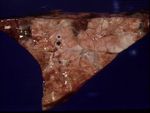Difference between revisions of "Bronchopneumonia"
Jump to navigation
Jump to search
| Line 36: | Line 36: | ||
**May develop into sequestra of necrotic tissue encapsulated by connective tissue | **May develop into sequestra of necrotic tissue encapsulated by connective tissue | ||
**Microscopically - massive exudation of plasma proteins into bronchioles and alveoli | **Microscopically - massive exudation of plasma proteins into bronchioles and alveoli | ||
| − | **Rarely resolves completely, leaves scars - pulmonary fibrosis and [[Pleuritis|pleural adhesions]] | + | **Rarely resolves completely, leaves scars - pulmonary fibrosis and [[Pleural Cavity & Membranes Inflammatory - Pathology#Pleuritis|pleural adhesions]] |
[[Category:Pneumonia]] | [[Category:Pneumonia]] | ||
Revision as of 18:51, 19 February 2011
- Originates and extends from terminal bronchioles
- Acute inflammatory exudate initially fills alveolar spaces radiating from the bronchioles causing areas of solidification of lung tissue termed consolidation
- In bronchopneumonia this consolidation is oriented around terminal bronchioles
- Most commonly occurs in cranioventral lung lobes and correlates with aerogenous portal of entry and gravitation of infectious droplets
- Most common form of pneumonia seen in domestic animals and the most common causes are bacterial and mycoplasma infections or aspiration
- Gross pathology:
- Affected parts are firmer (consolidated) than surrounding non-affected tissue
- Colour varies from red to pink to grey depending upon the stage of infection
- Extent of the lesion varies with the aetiological agent and the lobulation/septation of the species
- Micro pathology:
- Early cases centred upon the bronchiolar alveolar junction with exudation, which extends into neighbouring alveoli
- Exudate contains many neutrophils, macrophages and oedema
- Alveolar capillaries are hyperaemic
- Some haemorrhages in severe cases - later stages contain more cells than fluid
- Spread of the inflammation within the lung is usually by extension from lobule to lobule along the airways, or by necrosis of alveoli and septa in the case of toxin-producing bacteria
- Sequel to bronchopneumonia:
- Mild catarrhal inflammation resolves in 7 days and the lung is back to normal within 3 weeks
- More severe inflammation becomes chronic with fibrosis or bronchiectasis
- Abscess formation with pyogenic bacteria
- Pleuritis in severe fibrinous pneumonia with adhesions
- Death in fulminating cases due to hypoxaemia and toxaemia
- Suppurative bronchopneumonia
- Fibrinous pneumonia
- Predominantly fibrous exudate
- Exudate moves through pulmonary tissue to involve whole lung lobe
- Sometimes referred to as lobar pneumonia (below)
- Generally more severe than suppurative pneumonias
- Externally - severe congestion and haemorrhage, intense red colour with fibrinous plaques
- May develop into sequestra of necrotic tissue encapsulated by connective tissue
- Microscopically - massive exudation of plasma proteins into bronchioles and alveoli
- Rarely resolves completely, leaves scars - pulmonary fibrosis and pleural adhesions
